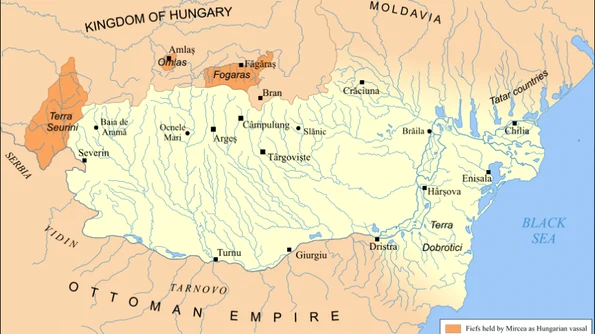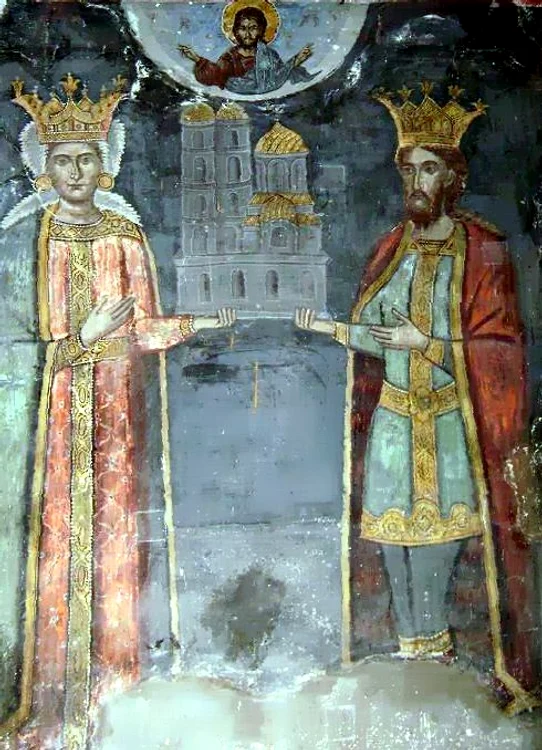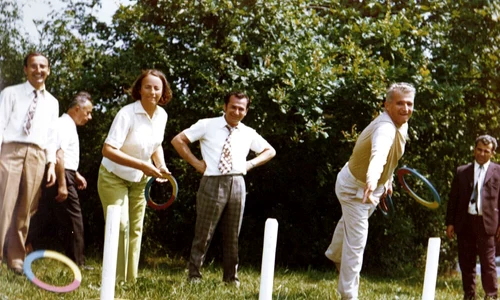
Neighbours of Islam: the early Florescus in the late 14th to early 16th centuries
The Bulgurs had already had their Empire and the Serbs their Tsars, the Magyars had already conquered the territory to the north and west of the Carpathan “crescent”, benefitting from that natural border against further incursions from the east and from the growing threat of Islam to the south, when the first mini-state of Wallachia began to emerge relatively late at the end of the 13th century. When it did emerge it did so almost by miracle, wedged as it was in that relatively small stretch of land between the Carpathians to the north and the Danube to the South, under the “foreign” dynasty of the Basarabs, most likely of Cuman origin, which will have many inter-actions with the Florescu family, as already noted by the late 19thcentury historian, Octav-George Lecca who referred to the:“vechea familea a Florestilor …strans rudita cu Basarabii”.
It so happens that in the late 14thcentury, when the first Wallachian state was still in its infancy, a man by the name of Florea, after whom his descendants two generations later were to call themselves “Florescu”, held extensive land holdings in a small triangle of land framed by the Danube to the south and the Olt to the east, next to the small Danubian fortified town of Severin, an area of crucial historical importance for the Romanian people. It was not far from Severin that Trajan had built his famous bridge to better control his Dacian conquests with the help of the architect Apollodorus of Damascus, a bridge which was later re-built by the Byzantine Emperor Justinian, adding a tower in honour of his wife Theodora. Thus the area of Severin was metaphorically but also literally the route through which Latinity entered the Romanian lands. We can presume that the region surrounding Severin was one of the most heavily Latizined in antiquity. Florea’s name itself suggests a Latin and not a Slavic origin. In the 6thcentury masses of Slavs settled in the same area with the encouragement of the Byzantine Emperors, having migrated there from parts of what is modern-day Ukraine, and they must have intermixed with the Dacio-Romans still left there, helping to create a new Romanian people. To this day, the region of Oltenia remains a kind of “hyper-Romania”, with its gently hilly landscapes, monastic foundations and rich ancient traditions of carpet-making and pottery, attesting to the historic continuity of this land.

Prince Radu I Basarab and his wife Ana Florescu
The Severin region at the time was at the epicentre of a huge geopolitical storm, with the increasingly powerful new Ottoman lands of Islam just across the Danube. Given the vulnerability of Florea’s lands to Ottoman raids and reprisals, it is not surprising that protecting this property from these raids was the main objective of the various early members of the Florescu family. Little is known about the fifth Basarab Prince, known as Radu I, who ruled Wallachia from 1377-1383, and therefore lived at the same time of Florea, but we do know that he married Florea’s sister Ana, who outlived him and then became a nun under the name of Calinichia. This was to be the first of a number of marriages between the Florescu and Basarab families. Indeed, marrying into Florea’s family may have been a way for the foreign-origin Basarab family, which had founded the nucleus of their state further north in the shadow of the Carpathian mountains, to extend its influence into the region of Severin. We do know that Radu I founded the Monastery of Tismana on lands owned by Florea, suggesting that this land had passed to the Basarabs by marriage.

The early Wallachian state was inherently unstable. Although the local ruling princes were almost exclusively drawn from the Basarab family, there were no clear succession rules and typically the Princes married more than once, producing different potential successors from different wives. Furthermore the local princes had to be confirmed by the council of local boyars. With powerful neighbours to the north and the Ottoman Empire to the south, a Basarab who wanted to accede to the princedom had to ensure the support of both a group of local boyars as well as powerful foreign sponsors, typically either the Porte, Transylvania, the Holy Roman Empire, Moldavia or further afield Poland. A local boyar’s survival depended on making good calculations and “backing the right horse”. Although we know little about Radu I, we know a lot about his son Mircea the Old, who did much to consolidate the early Wallachian state, joining the crusades against the Turks led by Sigismund of Luxembourg. It is interesting that in spite of close family ties, Florea’s only surviving son, whose name was Vlacsan, which meant Wolf in the Slavonic of the time, did not sit on Mircea the Old’s “divan” almost certainly because he did not wish to be associated with Mircea’s anti-Ottoman actions, fearing Turkish raids on his lands in the Severin area . When Mircea was forced to sign a treaty with the Turks, agreeing to pay them a tribute and to be “the friend of the friend of the Turks and an enemy of their enemies”, this was a vindication of the policy of Vlacsan and other Oltenian boyars, who had favoured a policy of appeasement towards the Ottomans.
When Vlacsan did join the Princely divan, the advisory council which formed the rudimentary government of the early Wallachian state, it was under Mircea’s son and successor Alexandru Aldea, becoming the first member of the Florescu family to sit on a divan. Although divan is a Turkish word which came to be used to describe the advisory council made up of close associates of the ruling prince, the various offices which made up the divan were typically borrowed from the neighbouring Serbian and Bulgarian courts, which themselves had borrowed or adapted them from the Byzantine court. Thus there was the Logofat or Chancellor, the Vistiarnic or Treasurer, the Vornic, a kind of administrator of justice, the Stolnic or Master of the Bedroom, the Paharnic or Cupbearer and the Cluciar, or Keeper of the Keys. Although Vlacsan sat on the council he appears not to have had a specific function on it, and was known simply by the generic title of Jupan, or “Lord”, denoting his belonging to the upper aristocracy of the land. He signed documents under the name of “Vlacsan son of Florea”, or sometimes under the slavic form of “Florev”.
The early 15thcentury saw a worrying increase in the Turkish threat to Wallachian lands. In 1413, a new Sultan Mehmed I, succeeded to the Ottoman throne, determined to reinvigorate the Muslim “ghazi” tradition of Holy War, resulting in an annual campaign against the “infidel” each spring. Alarmingly for Vlacsan as head of the Florescu family, Murad soon conquered Giurgiu and Turnu Magurele, two fortresses on the northern shore of the Danube, which, together with the Ottomon fortresses of Vidin, Nicopolis and Silistra on the opposing shore, allowed the Turks to encircle the southern borders of the Wallachian state, and use their new bases to raid Transylvania, which unlike Wallachia had not agreed to pay a tribute to the Ottomans, and therefore was not considered a friendly state. This in turn forced the Hungarians to move southwards, and re-occupy the provinces of Amlas and Fagaras which had been incorporated into Wallachia.
It is therefore not surprising that a new Basarab prince, Alexandru Aldea (1431-36), took a more acquiescent attitude to the Turks, providing support in their raids on Transylvania, including various attacks on the city of Brasov. We know that in 1432, Vlacsan, who was known for his pro-Turkish views, accompanied Aldea to Adrianople to sign an oath of allegiance to the Sultan. However, in 1433, Aldea appears to have had a change of heart, as he began to make overtures to Sigismond of Luxembourg, the new Holy Roman Empire, even travelling to the Catholic Council in Basel during that year and flirting with the idea of joining a new crusade against the Turks.

Vlad the Impaler, known as Dracula
But Aldea was never going to find favour in the “West”, known as he was as “Frater Turcorum”. Furthermore, his half-brother Vlad, later to become known to history as Vlad Dracul, was just the kind of protege Sigismund would have wanted on the Wallachian throne in lieuof Aldea. Vlad Dracul’s mother was a Hungarian Princess and he had spent much of his youth at the Hungarian court in Buda and other cities of the Holy Roman Empire. He had practically been adopted by Sigismond, giving him the kind of education he would have reserved for his own children, and in 1431, Vlad was initiated into the crusading “Order of the Dragon”, together with the Kings of Poland and Aragon, the Serbian despot and various other knights, and given the job of defending southern Transylvania against the Turks. Interestingly, it is at this time that he became known as Vlad Dracul (based on the Romanian word for devil or dragon), a name which he passed on to his son, the more famous Dracula, which essentially means son of Dracul.
Tensions between Vlad Dracul, supported by Sigismond, built up, and by 1436, open skirmishes broke out between the two rival princes’s supporters, leading to the death of Aldea in 1436 and Vlad Dracul’s succession to the throne that same year. However, Vlad Dacul soon had to reach his own accommodation with the Turks, due to the untimely death of Sigismond in 1437, depriving him of his greatest supporter in central Europe. Surely enough, Vlad Dracul was soon afterwards collaborating with the Sultan’s campaigns in Transylvania in 1438 and again two years later. It is probably due to this pragmatic change of heart of Vlad Dracul that Vlacsan re-entered Vlad Dracul’s “divan” in 1437, or was it because Vlad Dracul was pragmatic enough to recognize the need in include pro-Turkish boyars on his Council? Possibly a combnation of the two. In any event, Vlacsan entered as the third most senior ranking member out of a total of fourteen. We also know that Vlacsan accompanied Vlad Dracul on a visit to Sultan Murad in Adrianople in 1442, where the Sultan took Vlad Dracul’s two sons Vlad (later known as “the Impaler”) and Radu (“the Handsome”), hostage, as was customary at the time to “guarantee” Vlad Dracul’s ongoing loyalty to the Porte.

Strîmbu-Găiseni Church, build by Florescu family
It is around this time that the geographical focus of the Florescu estates changed, as in spite of Sigimond having issued three diplomas (on 14thJanuary 1418, 29thSeptember 1419, and 28thOctober 1428) confirming Vlacsan’s ownership of the monastery of Tismana, the old Florescu estates in the Severin region had by then been taken over by John Hunyadi, the Governor of Transylvania who had extended Hungarian conquests into this region. To compensate Vlacsan for this loss, Vlad Dracul awarded him new estates near the Răstoaca River, where a village which was named Floresti become the family’s main domain for the next 500 years.
Vlacsan is known to have retired from the divan in 1445, and must have died shortly thereafter. He left behind Vintila, his only male heir, a daughter, Vlada, who married a boyar of the powerful Craiovescu clan (considered the second most powerful family in Wallachia at the time, after the Basarabs, with their feudal base at Craiova);and a younger daughter called Maria. Vintila is interesting as he was the first member of the family to sign himself “Florescu”, after his grandfather Florea. This was almost unique at the time in Romania, where most documents were signed by dignitaries using first names and possibly a nick name, as Octav Georg Lecca, the 19thcentury historian of boyar families, noted: “E curios faptul ca [Vintila] e citat chiar in act [din 1483] “Jupan Vintila Florescu”, ceea ce e un caz aproape unic pe acele timpuri, deorece boerii Valahiei nu iau numele de familie decat tocmai in secolul al XVII-lea, mai ales dupa localitatii”.
We know that Vintila spoke fluent Turkish and he may even have spent some time in Constantinople as a “guarantee” that his father Vlacsan, along with the ruling Prince Aldea and other Wallachian boyars, would continue to remain loyal to the Porte. In any event, he survived and even flourished in the turbulent second half of the fifteenth century by continuing his father and grandfather’s policy of appeasing the Turks, continuing the pattern of getting involved in politics as long as the local Prince pursued a policy of appeasement towards the Turks, but keeping a low profile, at times even becoming an exile in Transylvania, during those times when a local Prince sought to challenge Turkish power in the region. This was the case in 1456 when the famous Vlad the Impaler (“Dracula”) was elected Prince, and started a policy of strengthening the Wallachian state by persecuting the local boyars and waging wars against the Turks.
However, Vintila’s fortunes soon changed when Dracula was eventually defeated by the Turks in 1462, ceding the throne to his younger brother Radu the Handsome, who had been thoroughly “Ottomanized” as a child in the Turkish court. Vintila and Radu may have known each other in captivity in Constantinople, and both favoured a policy of collaborating with the Turk, and therefore it was only natural when Vintila joined Radu the Handsome’s Divan in 1468. He was to remain on it until Radu’s first reign ended in 1473, when Radu was defeated by the Moldovan Prince Stephen the Great who managed to impose another relative, Basarab Laiota as his successor. During the next few years, which saw a rapid succession of local princes, including the brief return of Dracula to the throne in 1476 supported by Matthias Corvinus, Vintila appears to have stayed away from politics, being ostracised as a supporter of Radu the Handsome. In 1477, Prince Basarab Laiota’s Council even ordered the confiscation of all Vintila’s estates due to his earlier support for Radu the Handsome.
But things were soon to change for Vintila, and he pounced on his good luck when, with the support of Stephen the Great, a new Basarab Prince name Vlad “Tepelus”, or “the little Impaler“, managed to oust Laiota and get appointed Prince. Vintila immediately rallied behind Tepelus’ cause and entered his Divan, while Tepelus married Vintila’s sister Maria, who gave him a son called Danciu. This is the second marriage we know of between a Basarab and a Florescu. However, this was a highly unstable period and matters took a turn for the worse when Basarab Laiota managed to raid Vlad Tepelus’ stronghold at Targoviste, and kidnapped Maria and other women of the court, taking with him the princely treasure. This initiative was almost certainly an attempt to build up enough financial resources to influence the Ottoman court in a bid to take over from Vlad Tepelus as the ruling Prince. Maria was taken to Brasov and left in the care of Stephen Bathory, the Governor of Transylvania and a supporter of Laiota’s cause. A letter written by Vintila to his sister Maria in 1480, preserved to this day in the Brasov archives, suggests a strong bond between the two: “Only God know how anguished I am since your departure. I stand close to my Prince day and night thinking of ways to liberate you so that you can become our Princess once again. We place our faith in God to help us liberate you…We have sent gifts to Stephen Bathory for him to help out…I trust in God that our hopes will be fulfilled”. Eventually, it seems that the ample gifts of money (coupled with Basarab Laoita’s failing health) helped end the affair, and Maria and the other courtiers were liberated in 1481. But Vlad Tepelus himself died a year later, leaving Maria a widow with her son Danciu.
Maria would not remain alone for long, for in 1482 she further strengthened the ties between the Florescus and the Basarabs by marrying another half-brother of Dracula known to history as Vlad the Monk, whom she had probably spent some time with when in captivity in Basov. Vlad had fought Dracula for years from the area around Brasov with the support of the local Saxon community, whom Dracula had alienated. He then publicly abandoned his quest to be instated Prince by becoming a monk. However, on Dracula’s death in 1476, with the support of Stephen the Great, the Ottoman Sultan and the local boyars led by Vintila, Vlad gave up his monastic life and made a pitch for the Wallachian throne, eventually succeeding in 1481Cumpără acum. On his accession to the throne, Vlad the Monk duly appointed his brother-in-law Vintila as “Vornic” (the second highest position in the land after that of Ban, or vice governor, which had traditionally been held by the Craiovescus of Craiova). Accordingly, Vlad’s accession to the throne had enabled Vintila to become the most senior boyar on the Divan, and the second highest ranking nobleman. He generally signed himself Jupan, but occupied the function of Vornic and at times Vistier, until 1487, when he retired, probably to look after his estates.
Vlad the Monk’s rule, which provided a relatively long fourteen years of stability, was one of important internal administrative reforms and peace with the Turks, a policy which Vintila would surely have supported. The de factoautonomy of Craoiva and the surrounding region of Oltenia was formalized under the rule of a local Governor or Ban, typically from the Craiovescu clan, while a system of local prefects called Ispravnics governed other districts, and the various castles were each governed by a local Governor. Meanwhile, the Divan, or Boyars’ Council, grew in size and sophistication, with a more formalized hierarchy and more clearly defined functions. Vlad, always close to religious causes, also used these years of relative peace and prosperity to endow various monasteries with land, including Snagov, Tismana, Cozia and Comana, while defending the interests of Romanian merchants in their dealings with the Saxons of Transylvania.
Vintila’s sister Maria was disappointed when Vlad the Monk named Radu the Great, a son from his first wife, as his successor and duly retreated to Snagov Monastery where she took the monastic name of Mother Eupraxia. However, she had the consolation of seeing her own son Vlad (known as Vladut or Little Vlad) elected Prince in 1510. He only ruled for two years until he was murdered by a Turkish Pasha, whilst in turn his son Vlad ruled for another two years before being drowned by a group of boyars in the Dimbovitza River. Maria must have continued to live on for a number of years at Snagov, for Prince Neagoe Basarab, who ruled from 1512-21, is known to have given Snagov Monastery a substantial donation “in honour of Mother Eupaxia”. In the Monastery, there is still to this day a beautiful silver icon reflecting the Blessed Virgin given by an unknown prince, also in honour of Mother Eupraxia.
When Vintila died in 1494 or 1495, his son Draghici, who had been born around 1470, was the sole heir to the greatly Florescu extended family fortune which had been built up by Vintila, as well as the dynastic alliances of his aunt Maria, who had married two Basarab princes. Draghici, who would have a career spanning three decades, embarked on diplomatic several missions for his half-brother Prince Radu the Great, advocating the traditional Florescu policy of appeasing the Turks by arguing that the small Wallachian state “could not continue to fight against a Sultan who had conquered so many lands and so many armies”. Draghici was indeed arguing that it was preferable for the Wallachian state to retain a relative domestic autonomy whilst trading with the vast Ottoman Empire, rather than risk becoming a simple Turkish vassal state or Pashalik, like the states south of the Danube. This was increasingly justified because Wallachia had become part of an important trade route which spanned all the way from the Baltics states in the north down to the Ottoman Empire in the South and the Black Sea to the east. Furthermore, it should be remembered that this was a time of great uncertainly for the Wallachian state, as the Ottoman Empire enlarged its territory under the great leadership of Suleyman the Magnificent, culminating in the Ottoman victory at the Battle of Mohacs in 1526 which effectively turned the bulk of Hungary into a vassal state of the Ottomans.
After Radu the Great’s death, Draghici had the good fortune of serving one of the great Romanian princes of the time, Neagoe Basarab, becoming the seventh highest ranked member of Neagoe’s Divan (out of a total of twelve), holding the ranks of Cupbearer (1523), Vornic (1525), governor of the castle at Poienari, and then ending his career as Ban of Craiova, a position which had traditionally been held by the Craiovescu clan. It was Draghici who built the Monastery of Strambu in Gaiseni (which, although much ruined, still stands to this day not far from the current Bucharest-Pitesti highway) probably inspired by the great church building of Neagoe Basarab, including the construction of the original church of Curtea de Arges, later re-modelled in the 19thcentury. The Strambu Monastery was to became a kind of mausoleum where generations of the Florescu family were buried, including Draghici himself and his wife. Not far from the church was the Florescu mansion, which has not survived. Draghici ended his career by serving another Basarab Prince, Radu Paise (1535-45), for two years until his death in 1537.
One of the great achievements of the early Basarab rulers, and the leading Wallachian boyars who worked closely with them, was simply to ensure the survival of the Wallachian state as a political entity in the face of great historical odds. Earlier generations of Romanian historians have emphasized heroic battles against the Turks as the main reason for this survival. The truth is more prosaic: it was due to a combination of astute diplomacy, the payment of tribute and the occasional military victory. Facing the might of the Ottoman military engine, the calculations of the early Florescu’s were correct: it made absolute sense to reach a compromise with the Porte, for the alternative would have almost certainly ended up with Wallachia becoming a simple “pashalik” of the Ottoman Empire like Serbia, Greece, and even Transylvania and Hungary at one point, which would have meant its local culture and institutions being obliterated by the Turks. The early Florescu’s had not only survived these difficult times but also flourished in them, accumulating strong matrimonial alliances, lands and positions with in the Wallachina state. They had remained loyal followers of the Orthodox faith, endowing different monasteries with land and churches. They had shown great skills in dangerous times, in particular skills of diplomacy and politics. These skills would serve them well in centuries to come.
I would like to thank my late uncle, Professor Radu R. Florescu, Emeritus Professor of History at Boston College, who inspired my interest in our family history and in Romanian history in general. His latest book Dracula's Bloodlines, co-authored with the well-known medievalist Matei Cazacu, a researcher at the Centre National de la Recherche Scientifique in France, has provided me with muchof the sources and information used in this series of articles. The Romanian edition of this book is due to be published by Corinth later on this year .















